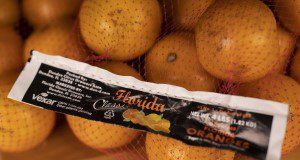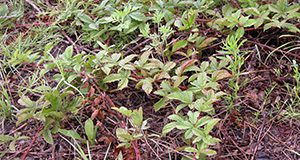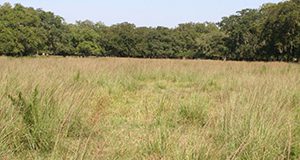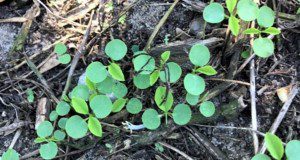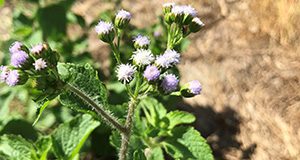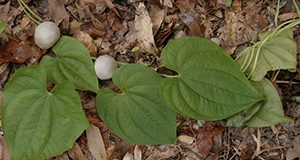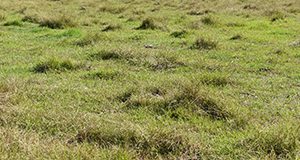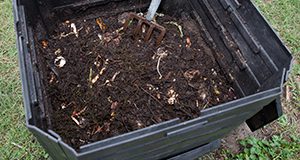This quick reference table will provide growers with information (suggested rates, use restrictions, etc.) on different herbicides used in citrus. The herbicide table, prepared based on the Florida Citrus Production Guide, will aid growers to select an appropriate postemergent herbicide program in citrus groves. Written by Ramdas Kanissery, Camille E. McAvoy, Jamie D. Burrow, Stephen H. Futch, Brent A. Sellers, and S. Shea Teems, and published by the UF/IFAS Horticultural Sciences Department.
https://edis.ifas.ufl.edu/hs1410
Tag: Brent A. Sellers
Blackberry and Dewberry: Biology and Control
Blackberry and dewberry are often viewed as nuisance weeds that reduce grazing in a portion of the pasture. However, severe financial losses can occur if these growing thickets injure cattle. This 4-page document provides information regarding blackberry and dewberry management in pastures. Written by Brent Sellers, Pratap Devkota, and Jason Ferrell, and published by the UF/IFAS Agronomy Department, revised November 2020.
https://edis.ifas.ufl.edu/ag238
Smutgrass Control in Perennial Grass Pastures
This 4-page document provides an overview of smutgrass biology, control, and general recommendations. Written by Brent Sellers, Neha Rana, José Luiz C. S. Dias, and Pratap Devkota, and published by the UF/IFAS Agronomy Department, revised October 2020.
https://edis.ifas.ufl.edu/aa261
Stock Plant and Tree Production: Weed Management in Citrus Nurseries
All citrus nursery stock in Florida is raised in enclosed greenhouses. It is not uncommon for weeds to grow in containers, where they compete with citrus seedlings, and on greenhouse floors, where they can harbor pests and diseases. This new 7-page publication of the UF/IFAS Horticultural Sciences Department provides descriptions of a few commonly found weeds in citrus nurseries and good weed management practices. Written by Biwek Gairhe, Ramdas Kanissery, and Brent Sellers, this article is chapter 8c of the forthcoming Citrus Nursery Production Guide.
https://edis.ifas.ufl.edu/hs1344
Identification and Management of Clustered Pellitory (Parietaria praetermissa) in Citrus Groves
In Florida, clustered pellitory is becoming a troublesome weed for citrus, especially from the winter through early summer. Inadequate management of this weed can result in its heavy infestation in tree rows and can interrupt the spray pattern of low-volume drip irrigation systems. This new 3-page publication of the UF/IFAS Horticultural Sciences Department will assist Florida citrus growers with proper identification of clustered pellitory and with adoption of adequate and timely strategies to manage this weed in their groves. Written by Ramdas Kanissery, Biwek Gairhe, Brent Sellers, and Steve Futch.
https://edis.ifas.ufl.edu/hs1341
Biology and Management of Tropical Whiteweed (Ageratum conyzoides) in Citrus Groves
This 3-page document profiles tropical whiteweed, a common weed of agriculture crops, wetlands, roadsides, and pastures in many parts of the world, and discusses how to manage this weed in citrus groves. Written by Ramdas Kanissery, Brent Sellers, and Steve Futch and published by the UF/IFAS Horticultural Sciences Department, January 2019.
http://edis.ifas.ufl.edu/hs1325
Integrated Management of Non-Native Plants in Natural Areas of Florida
While natural areas are conservation lands that have been set aside for the purpose of preserving (or restoring) native plant and animal communities, they do require active management. One of the greatest management issues in natural areas is invasive plants. This 35-page publication provides land managers in Florida with current methods used to manage non-native plants. Written by Stephen F. Enloe, Ken Langeland, Jason Ferrell, Brent Sellers, and Greg MacDonald, and published by the UF/IFAS Agronomy Department, revised July 2018.
http://edis.ifas.ufl.edu/wg209
Brunswickgrass or Paspalum nicorae: A Weed Contaminant in Southern Pastures and Bahiagrass Seed Production Fields
Brunswickgrass (Paspalum nicorae Parodi) is becoming a problematic weed in summer perennial grass pastures in the Southeast. The plant is competitive with bahiagrass
and bermudagrass. Since it is less palatable, it can eventually dominate a perennial grass pasture. Brunswickgrass has become naturalized and has reportedly contaminated bahiagrass seed fields and pastures in the southeastern states, including some of the important counties for seed production in Florida, such as Gilchrist, Levy, Alachua, Citrus, and Sumter. This 4-page fact sheet provides an overview of brunswickgrass and discusses its appearance, variety/germplasm, and management. Written by Ann Blount, Marcelo Wallau, Brent Sellers, Dennis Hancock, Leanne Dillard, Jose Dubeux, Cheryl Mackowiak, Joao Vendramini, and Clay Cooper, and published by the UF/IFAS Agronomy Department, April 2018.
http://edis.ifas.ufl.edu/ag408
Herbicide Residues in Manure, Compost, or Hay
When purchasing compost, it is important to understand that some manure-based products can contain herbicide residues that can affect the growth of certain plants. Manure from animals that have been fed forage treated with aminopyralid or other closely related herbicides, such as clopyralid or picloram, can be contaminated with these herbicides, which severely restrict the growth of legume and solanaceous crops and other broadleaf plants. This 3-page fact sheet discusses aminopyralid, compost, questions to ask when purchasing bulk compost or mulch, conducting a bioassay, aminopyralid injury symptoms, and steps to consider if contaminated manure or compost has been added to a garden or field site. Written by Jason Ferrell, Peter Dittmar, and Brent Sellers, and published by the UF Agronomy Department, May 2017.
http://edis.ifas.ufl.edu/ag416
2011 South Florida Beef Forage Survey Results
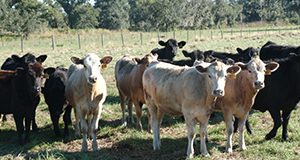 UF/IFAS Extension faculty and state specialists involved in the UF/IFAS South Florida Beef-Forage Program (SFBFP), in conjunction with the UF/IFAS Program Evaluation and Organizational Development unit, created a survey in 1982 that is used to evaluate ranch management practices. The survey is updated and distributed every five years to ranchers in 14 south Florida counties: Charlotte, Collier, DeSoto, Glades, Hardee, Hendry, Highlands, Hillsborough, Lee, Manatee, Martin, Okeechobee, Polk, and Sarasota. There were 102 anonymous responses in 2011. This 6-page fact sheet discusses characteristics of beef operations in south Florida, reproduction, production, marketing, herd health, nutrition, forage production, and environment. Written by Sonja Crawford, Christa Kirby, Tycee Prevatt, Brent Sellers, Maria Silveira, Bridget Stice, Joao Vendramini, and Lindsey Wiggins, and published by the UF Agronomy Department, October 2016.
UF/IFAS Extension faculty and state specialists involved in the UF/IFAS South Florida Beef-Forage Program (SFBFP), in conjunction with the UF/IFAS Program Evaluation and Organizational Development unit, created a survey in 1982 that is used to evaluate ranch management practices. The survey is updated and distributed every five years to ranchers in 14 south Florida counties: Charlotte, Collier, DeSoto, Glades, Hardee, Hendry, Highlands, Hillsborough, Lee, Manatee, Martin, Okeechobee, Polk, and Sarasota. There were 102 anonymous responses in 2011. This 6-page fact sheet discusses characteristics of beef operations in south Florida, reproduction, production, marketing, herd health, nutrition, forage production, and environment. Written by Sonja Crawford, Christa Kirby, Tycee Prevatt, Brent Sellers, Maria Silveira, Bridget Stice, Joao Vendramini, and Lindsey Wiggins, and published by the UF Agronomy Department, October 2016.
http://edis.ifas.ufl.edu/ag410
Biology and Management of Whitehead Broom in Pastures
Whitehead broom, also known as shrubby false buttonweed or southern larraflower, is becoming problematic in south Florida pastures, hayfields, and rights-of-way. This 2-page fact sheet discusses a few options to control this species. Written by Brent Sellers and James McWhorter, and published by the UF Agronomy Department, August 2016.
http://edis.ifas.ufl.edu/ag409
Cressleaf Groundsel (Butterweed) Identification and Management in Pastures
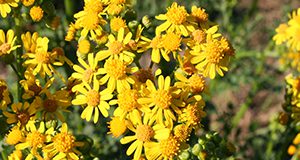 Butterweed is a winter annual that is toxic to both cattle and horses. This 2-page fact sheet provides an overview of the plant as well as herbicide recommendations. Written by Brent Sellers and Jay Ferrell, and published by the UF Agronomy Department, May 2016.
Butterweed is a winter annual that is toxic to both cattle and horses. This 2-page fact sheet provides an overview of the plant as well as herbicide recommendations. Written by Brent Sellers and Jay Ferrell, and published by the UF Agronomy Department, May 2016.
http://edis.ifas.ufl.edu/ag406
Spiderwort Control in Hay Fields and Pastures
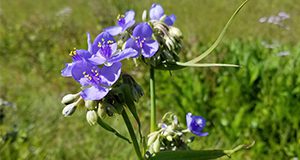
Spiderwort is a native perennial species found throughout the eastern half of the US. The plant’s large, fleshy stem creates problems for hay production. This 2-page fact sheet provides a brief overview of the plant as well as information on control through herbicide use. Written by Michael Durham, Jason Ferrell, and Brent Sellers, and published by the UF Agronomy Department, May 2016.
http://edis.ifas.ufl.edu/ag407
Suggested Weed Control Programs for Citrus
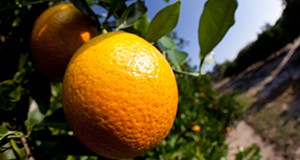
Weed management is an important component of citrus production. The selection and implementation of a weed management program can lead to both economic and environmental returns. This three-page fact sheet details how to manage weeds in both young and mature groves, the differences in weed control programs between interior areas and coastal or flatwoods areas, how to control weeds after a freeze, and common ways that herbicides are misused. Written by Stephen H. Futch and Brent Sellers, and published by the Horticultural Sciences Department.
http://edis.ifas.ufl.edu/ch084
Maximizing Weed Control in Florida Citrus
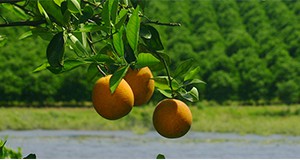
With Florida citrus growers and production managers being “squeezed” between rising production prices and declining yields from citrus greening, there’s more call than ever to reduce citrus production costs. Controlling weeds is a major expense, amounting to 11% of the total $2,278 annual production cost per acre for the 2014–2015 season. This 3-page fact sheet teaches the six essential components of an effective weed-management program to help maintain the profitability of this vital Florida industry. Written by Stephen H. Futch and Brent Sellers and published by the Horticultural Sciences Department. http://edis.ifas.ufl.edu/hs237
Creeping Indigo, A Poisonous Plant of Concern in Florida Pastures
 A recent rise in suspected horse poisonings has brought new attention to creeping indigo (Indigofera spicata), a toxic plant which has reportedly been in Florida for as long as 90 years. This new 5-page fact sheet covers plant description, signs of creeping indigo toxicity, and roles of creeping indigo’s toxins, as well as treatment and management. Written by Robert MacKay, Ed Jennings, Brent Sellers, Jason Ferrell, and Amanda House, and published by the UF Department of Agronomy, August 2015.
A recent rise in suspected horse poisonings has brought new attention to creeping indigo (Indigofera spicata), a toxic plant which has reportedly been in Florida for as long as 90 years. This new 5-page fact sheet covers plant description, signs of creeping indigo toxicity, and roles of creeping indigo’s toxins, as well as treatment and management. Written by Robert MacKay, Ed Jennings, Brent Sellers, Jason Ferrell, and Amanda House, and published by the UF Department of Agronomy, August 2015.
http://edis.ifas.ufl.edu/ag399
Smutgrass Control in Perennial Grass Pastures
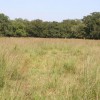 Smutgrass is a serious weed of improved perennial grass pastures, roadsides, natural areas, and waste areas in Florida. A 2003 survey found that smutgrass was second only to tropical soda apple as the most problematic weed species in Florida pastures, but now that practices to control tropical soda apple have been widely adopted in Florida, smutgrass is likely the most problematic weed species in Florida pastures today. This 4-page fact sheet was written by Brent Sellers, J. A. Ferrell, and N. Rana, and published by the UF Department of Agronomy, January 2015. (Photo Credit: B. Sellers, UF/IFAS)
Smutgrass is a serious weed of improved perennial grass pastures, roadsides, natural areas, and waste areas in Florida. A 2003 survey found that smutgrass was second only to tropical soda apple as the most problematic weed species in Florida pastures, but now that practices to control tropical soda apple have been widely adopted in Florida, smutgrass is likely the most problematic weed species in Florida pastures today. This 4-page fact sheet was written by Brent Sellers, J. A. Ferrell, and N. Rana, and published by the UF Department of Agronomy, January 2015. (Photo Credit: B. Sellers, UF/IFAS)
http://edis.ifas.ufl.edu/aa261
Managing Against the Development of Herbicide-Resistant Weeds: Sugarcane
 Profitable sugarcane production in Florida requires effective weed management. Herbicides provide an efficient and cost-effective means of weed control, but excessive use of a single herbicide or group of herbicides with the same mechanism of action has resulted in the development of herbicide-resistant weeds. In crops such as sugarcane where a limited number of herbicides are registered, the loss of a single effective herbicide can be very costly. Thus, it is critical to manage herbicides in order to prevent or delay the development of herbicide-resistant weed populations. This 4-page fact sheet lists herbicides by group number, mechanism of action, chemical family, common name, and trade name. Written by D.C. Odero, B.A. Sellers, J.A. Ferrell, and G.E. MacDonald, and published by the UF Department of Agronomy, October 2014.
Profitable sugarcane production in Florida requires effective weed management. Herbicides provide an efficient and cost-effective means of weed control, but excessive use of a single herbicide or group of herbicides with the same mechanism of action has resulted in the development of herbicide-resistant weeds. In crops such as sugarcane where a limited number of herbicides are registered, the loss of a single effective herbicide can be very costly. Thus, it is critical to manage herbicides in order to prevent or delay the development of herbicide-resistant weed populations. This 4-page fact sheet lists herbicides by group number, mechanism of action, chemical family, common name, and trade name. Written by D.C. Odero, B.A. Sellers, J.A. Ferrell, and G.E. MacDonald, and published by the UF Department of Agronomy, October 2014.
http://edis.ifas.ufl.edu/sc077
Identification and Control of Coral Ardisia (Ardisia crenata): A Potentially Poisonous Plant.
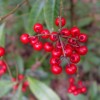 Coral ardisia, also known as coral berry, spice berry, and scratchthroat, was introduced to Florida in the early 1900’s for ornamental purposes. Since then, it has escaped cultivation, and it is found in hardwood hammocks and other moist, natural-wooded areas and grazing lands. Although there is no published literature supporting the theory that coral ardisia is toxic, it is suspected that the berries and/or foliage are poisonous to livestock, pets, and humans. This 3-page fact sheet was written by B. A. Sellers, Sarah Lancaster, K. A. Langeland, J.A. Ferrell, Michael Meisenberg, and J. Walter, and published by the UF Department of Agronomy, November 2013.
Coral ardisia, also known as coral berry, spice berry, and scratchthroat, was introduced to Florida in the early 1900’s for ornamental purposes. Since then, it has escaped cultivation, and it is found in hardwood hammocks and other moist, natural-wooded areas and grazing lands. Although there is no published literature supporting the theory that coral ardisia is toxic, it is suspected that the berries and/or foliage are poisonous to livestock, pets, and humans. This 3-page fact sheet was written by B. A. Sellers, Sarah Lancaster, K. A. Langeland, J.A. Ferrell, Michael Meisenberg, and J. Walter, and published by the UF Department of Agronomy, November 2013.
http://edis.ifas.ufl.edu/ag281
Wildland Weeds: Paragrass, Urochloa mutica (SSAGR370/AG375)
 Paragrass (also referred to as Californiagrass) is thought to have been introduced into Florida sometime in the late 1870s as a forage plant. The semiaquatic grass is a native of tropical Africa, and today it is established in both hemispheres in tropical and subtropical regions as a highly palatable fodder. The grass is established in regions of poorly drained soils and along freshwater shorelines in Alabama, Florida, Hawaii, Maryland, Oregon, South Carolina, and Texas. It is an extremely aggressive competitor that can displace many shoreline emergent plants and plants in cultivated or disturbed sites associated with moist soil. Paragrass becomes readily established in wet soils along shorelines where it can form large monocultures. This 4-page fact sheet was written by L. T. Markle, B. A. Sellers, and W. A. Overholt, and published by the UF Department of Agronomy, April 2013.
Paragrass (also referred to as Californiagrass) is thought to have been introduced into Florida sometime in the late 1870s as a forage plant. The semiaquatic grass is a native of tropical Africa, and today it is established in both hemispheres in tropical and subtropical regions as a highly palatable fodder. The grass is established in regions of poorly drained soils and along freshwater shorelines in Alabama, Florida, Hawaii, Maryland, Oregon, South Carolina, and Texas. It is an extremely aggressive competitor that can displace many shoreline emergent plants and plants in cultivated or disturbed sites associated with moist soil. Paragrass becomes readily established in wet soils along shorelines where it can form large monocultures. This 4-page fact sheet was written by L. T. Markle, B. A. Sellers, and W. A. Overholt, and published by the UF Department of Agronomy, April 2013.
http://edis.ifas.ufl.edu/ag375
